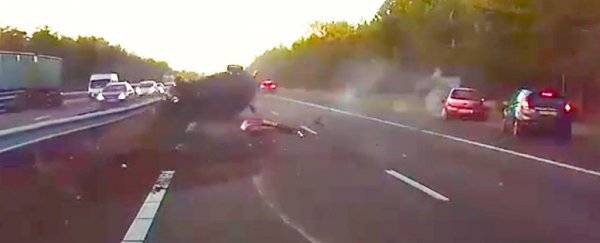There's been a fair amount of controversy over Tesla's Autopilot feature, so if you've got your doubts about the capabilities of assisted driving technology when it comes to preventing accidents, it's worth taking a look at this.
New dashcam footage from the Netherlands shows the safety features in Tesla Autopilot detect a potential highway collision between the two cars travelling ahead of the driver, just moments before a violent impact takes place.
In the video, which was shared online by Twitter user Hans Noordsij, you can see traffic moving along at a brisk pace on a two-lane highway. According to the dashcam readout, the cruising speed was 113 km/hr (70 mph).
All of a sudden, an alert can be heard in the car, which is Autopilot's Forward Collision Warning system warning that it has detected a potential impact up ahead.

Only about a second later, the car directly ahead of the dashcam vehicle slams into the rear corner of the SUV in front of it. It's a major collision too, causing the SUV to roll over nearly twice before coming to a rest on its side.
After sounding the alarm, the Tesla's emergency braking kicks in, moments before the driver manually brakes.
Luckily, nobody was killed in this serious accident, which looks to have been caused by the driver of the hatchback not paying enough attention to the road ahead. If they had been, they would have noticed that the SUV was braking due to traffic.
But how did the Tesla know about this potential impact before it actually happened?
In September, the company rolled out an over-the-air update with the 8th version of its Autopilot software, adding extra radar processing features to Tesla models to pick up potential collisions that the primary camera and image processing system can't always detect.
In this case, the dashcam footage makes it look like an alert driver should have noticed the potential collision between the two cars ahead – particularly because it's easier to see the large SUV that's only partially obscured by the smaller hatchback.
Original video, authorisation from the owner. Essential, no one could predict the accident but the radar did and acted by emergency braking. pic.twitter.com/70MySRiHGR
— Hans Noordsij (@HansNoordsij) December 27, 2016
But what if the vehicles' positions were switched around? It would be harder to see the hatchback braking in front of the SUV – and if the SUV were an even larger vehicle, like a truck, it might have been impossible for the human driver in the Tesla to detect the potential collision and slow down accordingly.
Which is where the Autopilot's new radar support comes in handy. When Tesla announced the update in September, it basically envisaged the feature preventing additional collisions just like in the Netherlands video:
"Taking this one step further, a Tesla will also be able to bounce the radar signal under a vehicle in front – using the radar pulse signature and photon time of flight to distinguish the signal – and still brake even when trailing a car that is opaque to both vision and radar. The car in front might hit [an object] in dense fog, but the Tesla will not."
According to Tesla, it's not easy to incorporate radar as a primary control sensor in vehicles without the camera system also visually confirming the objects detected.
Why? Because of the way that photons travel and bounce off different kinds of surfaces. Tesla says to a radar system, people appear partially translucent, and wood and plastic are almost transparent.
On the other hand, metallic surfaces – particularly round or dish-shaped ones – amplify the signal, meaning a soft drink can on the side of the road can look like a dangerously large obstacle to the radar.
Tesla says it solved these issues in its updated Autopilot, with the new software enabling more calculations of 3D objects to get a better sense of the world around the car.
It's still not perfect, but the company thinks its radar technology will improve further with more similarly equipped cars on the road, with a fleet of vehicles uploading radar data about objects on the road and driving conditions.
Of course, Autopilot is still a new feature, and it should never be used as an excuse for human drivers to take their eyes off the road.
But it's good to know that assisted driving technology is getting to the point where it can help us to avoid accidents in circumstances where our own eyes might not be able to perceive the very real dangers ahead.
Drive safely, everybody!
